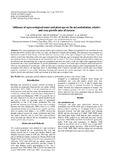| dc.contributor.author | Githunguri, C. M | |
| dc.contributor.author | Waithaka, Kimani | |
| dc.contributor.author | Ekanayake, I. J | |
| dc.contributor.author | Imungi, J. K | |
| dc.date.accessioned | 2013-06-15T11:18:59Z | |
| dc.date.available | 2013-06-15T11:18:59Z | |
| dc.date.issued | 2007 | |
| dc.identifier.citation | C. M. Githunguri, Kimani Waithaka, I. J. Ekanayake, & J. K. Imungi (2007). Influence of agro-ecological zones and plant age on the net assimilation, relative and crop growth rates of cassava.. African Crop Science Conference Proceedings Vol. 8. pp. 1531-1533 | en |
| dc.identifier.uri | http://hdl.handle.net/11295/34413 | |
| dc.description.abstract | Five cassava genotypes were grown at three agro-ecological zones. Plants were sampled for net assimilation, crop growth and relative growth rates at four, six, eight, ten and twelve months after planting. The genotypes were arranged in a randomized complete block design, with four replicates. Cassava at the wetter agro-ecological zones had higher crop and relative growth rates than those at the drier agro-ecological zone. Plant age, agro-ecological zone and genotype effects were not important factors in determining the net assimilation rate of cassava. The lowest yielding genotype had the highest net assimilation rate demonstrating that a high net assimilation rate does not always result into high yields suggesting that net assimilation rate is not a good indicator of growth performance of cassava. The wetter agro-ecological zones had a positive effect on crop and relative growth rates, while the drier agro-ecological zone had a negative effect suggesting that the agro¬ecological zone effect is an important factor in determining them. Cassava crop and relative growth rates were highly positively correlated to root yields. Therefore, breeding and selection for cassava genotypes with the highest crop and relative growth rates and hence yields may be done at the drier agro-ecological zone. | en |
| dc.language.iso | en | en |
| dc.title | Influence of agro-ecological zones and plant age on the net assimilation, relative and crop growth rates of cassava. | en |
| dc.type | Presentation | en |
| local.publisher | lKenya Agricultural Research Institute, Machakos, Kenya | en |
| local.publisher | International Institute of Tropical Agriculture, IITA, c/o L.W. Lambourn & Co., Carolyn House 26, Dingwall Road | en |
| local.publisher | Department of Plant Science and Crop Protection, University of Nairobi, Kenya | en |

